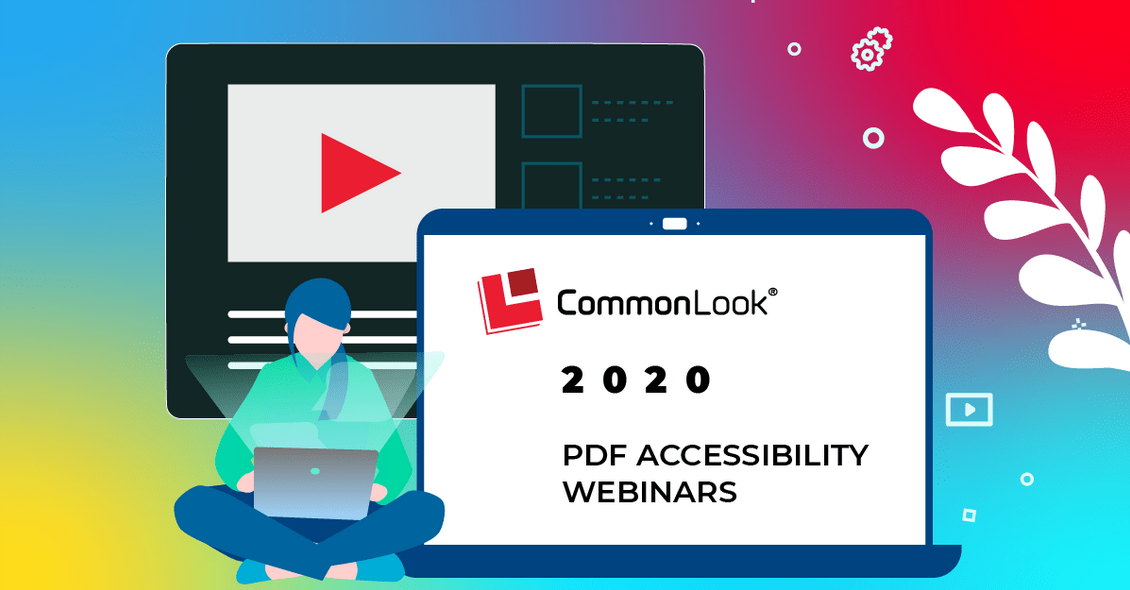

Part of NewFormat AB Portal
NewFormat AB
Webinars and video recordings

Presentations of our solutions and demonstration of practical use cases



Presentations of our solutions and demonstration of practical use cases

If your website has public-facing documents,
then they need to be digitally accessible to everyone,
including people with disabilities.
CommonLook offers a set of accessibility software tools that can help
make your website and other digital assets that host digital documents,
like PDF and Word) digitally accessible to everyone.
CommonLook is a global leader in electronic document accessibility,
providing software products and professional services enabling faster,
more cost-efficient, and more reliable processes for achieving compliance
with the leading PDF and document accessibility standards,
including WCAG, PDF/UA and Section 508.
CommonLook's product family makes the creation, remediation and management of
PDF and Microsoft Office documents easier than ever before and its services
ensure best-in-class remediation results as the only provider of a comprehensive
Section 508 or WCAG compliance certificate for each remediated document.
Unlike other PDF verification products,
PDF Validator provides users with a certification report for each tested document.
Communications and compliance specialists can rest assured that their PDFs
are compliant with accessibility standards.
With other verification products, it’s not uncommon that documents will pass the tests,
but still not be accessible and compliant.
CommonLook PDF enables teams to produce high quality remediated documents, quickly and efficiently.
It simplifies and accelerates remediation tasks while injecting a methodology into the remediation process.
This functionally rich solution is the premier choice for industry professionals concerned with
ensuring compliance with accessibility standards.
General PDF Accessibility Webinars.
For all levels of knowledge in PDF Accessibility.
Don’t miss your chance to learn for free!
PDF Accessibility Tech Series Webinars.
Based on the CommonLook PDF Workflow Recommendations.

Document Accessibility is a Requirement:
Choosing Between Outsourced Remediation and Software Tools – What is Your Best Option?
April 16, 2020 (42:24)
Description: Section 508 and the ADA mandates that PDF documents on your website
must be accessible and standards-compliant to a minimum WCAG 2.0 AA.
This webinar will discuss what this means for most organizations and
the two options available to solve the problem.
What Makes a Document Accessible and Standards-Compliant?
April 21, 2020 (1:02:07)
Description: In this first part of our technical series,
we will do a deep dive into exactly what makes a
PDF document accessible and standards-compliant.
Adobe Acrobat vs CommonLook PDF.
April 23, 2020 (41:41)
Description: The W3C, who developed the WCAG standards,
lists Adobe Acrobat and CommonLook PDF as the tools for
remediating documents for accessibility.
In this webinar, we will review both tools and show how CommonLook PDF
can save time and money in remediation costs as well as
certify documents for compliance with the accessibility standards.
Document Preparation:
How to Get Started and Prepare a Document for Remediation
Including Checking for Color/Contrast Issues.
April 28, 2020 (45:51)
Description: In the second part of this 10-part technical series,
we will review what needs to be done to a document before
you start working on the tagging and the tags tree.
You Get What You Pay For:
Cost of Low-Quality PDF Remediation Vs Guaranteed Quality PDF Remediation.
April 30, 2020 (49:16)
Description: Many organizations rely on outsourcing of document remediation projects
which can quickly solve the problem especially for large volumes of documents.
But how do you know you are getting what you are paying for?
In this webinar, we will discuss how to ensure your documents are standards compliant
and how to properly vet vendors to ensure a successful outcome.
How to Verify Reading Order.
May 5, 2020 (36:29)
Description: The third part of our technical series covers
the importance of reading order in ensuring accessible PDF documents.
We will review the definition of reading order and then practical tips
to verify reading order is correct in your documents.
How to Audit a Website for Document Accessibility Compliance.
May 7, 2020 (53:01)
Description: Websites have become huge repositories for PDF documents.
So how do you itemize and audit these documents for accessibility compliance?
In this webinar, we review the problem and show how tools like
CommonLook PDF Validator (which is a free tool) and CommonLook Clarity
can be used to audit your website for document accessibility compliance.
Verification of Correct Tag Use and Common Mistakes.
May 12, 2020 (53:39)
Description: In the fourth part of our series, we discuss the correct use of tags.
Adobe Acrobat DC will add tags to a document as part of the accessibility features in the tool.
But this first step is just the beginning and the tags need to be verified
to ensure they are correct for the content type.
There are common misunderstandings about the correct tags for particular content,
so we will review those as well.
How to Prepare a Well-Written RFP for Document Remediation (Federal, State and Local Gov).
May 14, 2020 (51:37)
Description: With the push by many organizations to get their web sites in compliance
with the accessibility standards, many organizations have released RFP’s for large projects.
Many of these RFP’s are designed to get the lowest price possible but leave many gaps
in the process that can leave your organization legally liable.
In this webinar, we will discuss how to write an RFP that will have the necessary
components to help ensure you get a low price and the most qualified bidder.
Tables and Complex Tables.
May 19, 2020 (48:12)
Description: The fifth part will cover the topic of how to deal with making tables accessible.
Tables, especially complex tables are a difficult content type that even
professional document remediators often times will struggle with mastering.
In this session, we will discuss how tables need to be properly tagged and
show how this difficult content can be easily remediated using tools such as CL PDF.
AB-434: Document Accessibility is a Process, Not a Project.
May 21, 2020 (47:55)
Description: AB-434 has been extended for another year and many California agencies
are continuing to work on their projects for compliance.
But do you view AB-434 as a project to compete or as part of a
compliance program that ensures new content is accessible as part of the process?
In this webinar, we will discuss how several California Agencies are developing document
accessibility programs that will work for them to ensure accessible content is the new norm.
Lists, Table of Contents.
May 26, 2020 (54:08)
Description: The sixth part of our series will cover lists and Table of Contents (TOC).
Forms in PDF - Including Both Document Prep/Forms Creation and Tagging.
June 2, 2020 (56:29)
Description: The seventh part of our series will discuss fillable forms
as these can be very difficult to remediate correctly.
Links Including Doc Prep/Creation As Well as Tagging?
June 9, 2020 (40:35)
Description: The eighth part of the series will review how to ensure
that links are tagged correctly and how to ensure the source document
is correctly prepared to ensure the content is accessible.
10 Documents Accessibility Errors you Can Fix Now.
June 12, 2020 (41:19)
Description: Every organization needs to be concerned about accessibility
and should work towards ensuring that everyone has equal access.
We all understand that there are legal requirements to do so,
but where do you begin and how do you deal with document accessibility issues?
Headers and Footers.
June 16, 2020 (27:27)
Description: The ninth part of the series discusses in detail
how to deal with headers and footers in PDF documents.
Headers and footers are handled differently than normal content
and need to be tagged correctly to work well with screen readers.
Final Checks, Metadata and Cleanup and Verification Reporting
(using CommonL Validator or PDF).
June 23, 2020 (38:13)
Description: The tenth and final part of our technical series of webinars
demonstrates how CommonLook PDF Validator (a free tool) or CommonLook PDF
can generate verification reports for the accessibility standards for your organization.
Accessibility, automation and AI: The future of accessible PDF documents
So how do you deal with PDF documents that are generated
from databases to ensure they are accessible?
CommonLook demonstrates the Dynamic tool and how
the U.S. Veterans Administration uses it to create
accessible PDF documents on the fly.
Planning for PDF accessibility within your organization
Organizations' challenges, pitfalls, and how to address/avoid them
Microsoft Word and Accessibility:
If you are authoring documents in Microsoft Word (or presentations in MS PowerPoint)
and converting them into PDFs, the accessibility features available in these
Microsoft products do not always translate over to the PDF version.
CommonLook's accessibility plugin for Microsoft Office (Word and PowerPoint)
will help you ensure that, upon creation, your PDF is accessible and
will not need any additional remediation!
What you will learn:
We will discuss the CommonLook Office GlobalAccess,
industry’s most-advanced Office plugin’s workflow and
show how the accessibility application may be used to quickly
check, fix, and verify Word documents for accessibility before converting them
to tagged and read by assistive technology to achieve accessible PDFs.
CommonLook Tools - CommonLook Office and CommonLook PDF - for PDF Accessibility, by Ferass Elrayes
For more information contact NewFormat
NewFormat AB
Smörblommegränd 14, SE-165 72 Hässelby (Stockholm), Sweden
tel:+46 (0)70 631 53 01
All content © copyright 2008-2024 NewFormat AB. All rights reserved.
All product names, trademarks and registered trademarks
are property of their respective owners.